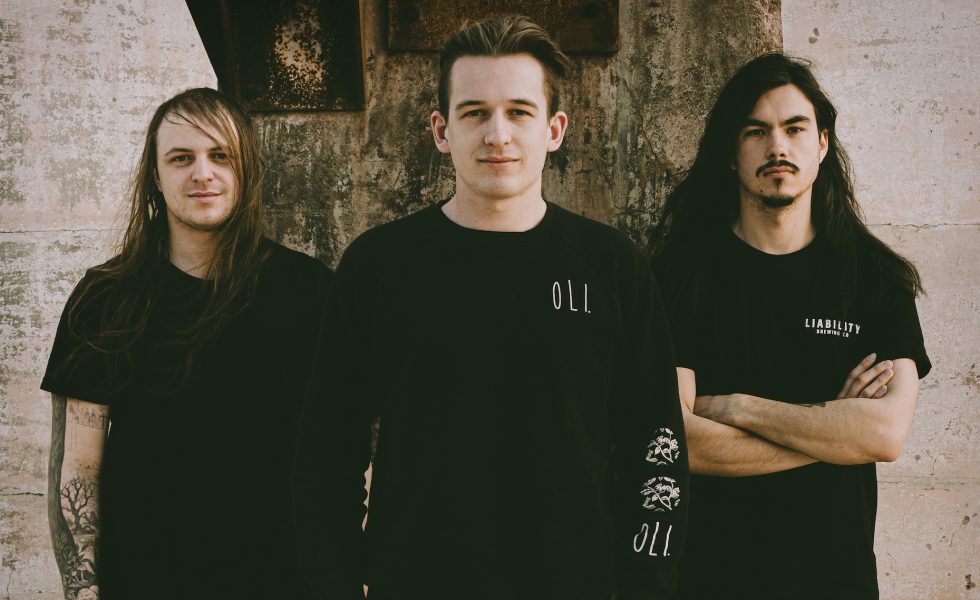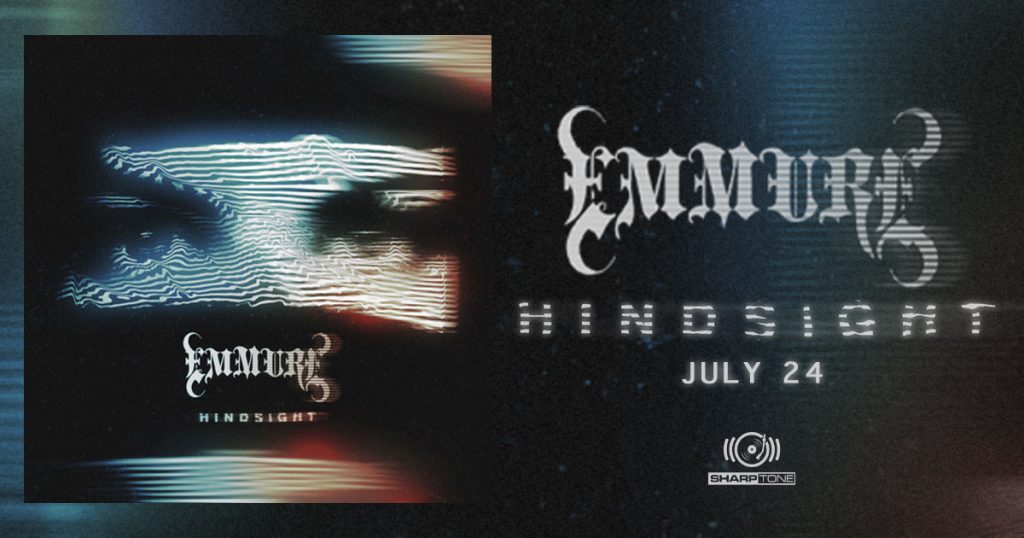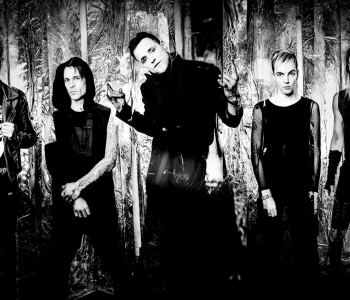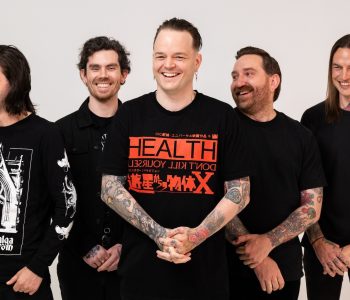Korn‘s Jonathan Davis was so excited by ORGY that he created his own record label …
Axiomatic Theory is a three-piece band from Canberra whose music is a mixture of technical melodic complexities and heavily grooving breakdowns.
MORE: IN HEARTS WAKE: The Age Of Kaliyuga // DEFTONES: 20 Years Of Whit Pony // GREY DAZE: Making Amends // MAKE THEM SUFFER: A Shift Between Light & Dark REVIEWS: LAMB OF GOD: Lamb Of God // MAKE THEM SUFFER: How To Survive A Funeral // EMMURE: Hindsight // GREY DAZE: Amends // FANGZ: But No Thanks // AXIOMATIC THEORY: Existential Flux
With no vocalist or bassist, the trio relies on pairing two eight-string guitars with drums and influences from Classical and technical metal to create their sound. The first recorded work from this inspired collective is Existential Flux, a full-length album released this month across all digital platforms. Guitarist and founding member Owen Elliot explains the band’s history and aesthetic, and what it’s like to be an instrumental band playing live in a small city.
First things first, how long has Axiomatic Theory been working together now?
I started writing the music a number of years ago now, probably in about 2015. We got the band together with Nic [Johnson] and Sam [Angel] in early 2018. Sam’s on drums and Nic and I play eight-string guitars.
How much of the material had you written for the album before you joined up with the other lads? Did the music change much once there were three of you working together?
Probably about half the album was written before we got together. Sam added his own flair to the drum parts and has also written a few sections as well. It was nice building onto the body of work I already had with those guys, to put together the album.
The term axiomatic theory relates to a lot of pure mathematics and geometrics. Given the nature of your music, Axiomatic Theory is about as perfect a name as possible. Did that just come about naturally?
We originally had a few ideas for names, and we narrowed them down from a few that had already been taken. We landed on Axiomatic Theory because we liked the sound of it, and fifteen characters works very nicely with symmetries and logos and whatnot. An axiom is a set of rules, and so an axiomatic theory is a theory that’s built on a set of rules. A lot of our music, and the titles, are inspired by a lot of concepts in mathematics, and computer science. That’s where our sound comes from as well. It’s methodical and calculated. Musical theory has a lot of mathematical basis to it, and that’s where it all derives from, especially from classical musical theory, which is a big influence in our music.
One of my concerns, when we first started playing, was how people would react to hearing this sort of stuff live; whether we would capture attention for a whole set.
[ Owen Elliot ]
The album artwork definitely fits into the band aesthetic. No one could mistake a mathematical influence from looking at the geometrical design on the cover.
It was inspired by the track Hexacosichoron, which is a high dimensional shape. When we were looking for the artwork, we were looking for something geometrical like that. It isn’t a hexacosichoron [a theoretical geometric 4D figure with 600 faces], but we wanted something similar to that. We wanted an impossible shape. The more you look at this one, the more different ideas of trying to make it appear 3D pop out, because the lines cross over in ways that don’t make sense!
The final quarter of the album is given over to the three part title suite, Existential Flux. Was that always conceived as a multi-part track, or did it develop that way over time?
That one was written over the longest timespan. Creation was one of the first things I came up with for the band years ago, and Chaos Theory being, I think, the last thing we wrote before we recorded the album. So it was developed over two or three years, and I always had the idea that it would be a two- or three-movement work when I started with Creation. I always had that in mind when I was writing it.
The electronic elements of Existential Matrix certainly add a further dimension to the sound.
We had a few of those ideas ready when we were recording, like the ones in Hexacosichoron, the harpsichord in There and Back Again and a lot of the orchestral stuff in the Existenial Fluxes. But we were fortunate to work with Steve Zumstein with production and mixing and he guided us with mixing those in and just bringing it to life in that regard. For example, the opening to Confusion Matrix. That was almost completely come up with by him, and we really liked that. It was awesome to have a little bit of extra collaboration when we were recording and putting it together, and we learned a lot from that.
Have you done a lot of live work? How does a three-piece technical instrumental band come across in the live scenario?
We have played a few shows here and there around Canberra. We want to do more interstate stuff, but obviously that’s all been put on hold unfortunately. It’s interesting to keep the audience engaged when you don’t have a vocalist to take that usual frontman role. I tend to do a lot of talking on stage, but mostly we tend to stick to just smashing out the tracks. People seem to enjoy us playing live. We have a lot of sections that are a little bit more deathcore influences with big breakdowns and people really get into those sections when we’re playing live, so I think we have enough of a balance between the parts that are technical and interesting to watch and the ones that are heavier that the audience can get involved in. It seems to run well live, which is good. One of my concerns, when we first started playing, was how people would react to hearing this sort of stuff live; whether we would capture attention for a whole set.
Canberra has always had a small but vibrant live music scene. Has it been tough trying to fit your band in with other acts on the scene?
It’s interesting playing in Canberra. There’s not an enormous group of instrumental metal bands in the city, so we’re often playing with much heavier groups like deathcore bands. We’ve also done a lot of gigs with punk bands and indie bands, and it’s been great being instrumental and bridging some of the technical melodic stuff with the breakdowns so we’ve been able to slot ourselves into a lot of varying gigs, which has been good. We have been able to offer a great deal of versatility, which is nice.
Was there ever any plans for the band to have a singer or a bass player?
From the onset, instrumental was the goal. Initially I was inspired by Animals as Leaders, and they have the same ensemble, obviously, which is drums and two eight-strings. That’s what kicked it off, that idea.
That’s probably the first band anyone will think of when they’re looking for comparisons. With the format of Axiomatic Theory, you’re probably always going to run up against comparisons with Animals as Leaders.
They were more of an influence of the structure of the band, rather than anything that was written for it. Primarily, Animals as Leaders have a much more jazz-influenced aspect to their music, and we’re more Classical influenced. When I first got into this stuff, they were such an anomaly, with such a small ensemble. It’s so common for bands to have two or three guitarists, bass, vocals… I kind of liked the idea of having a small group. We all get on really well and enjoy playing together, and that’s another reason why we’ve never considered adding any vocals or getting a bassist or anything. We chucked some bass on the album, but when you’re playing live, you don’t really need it with the eight-strings. We have to take that into account with the writing of it, as well. We often have one of us playing in the lower register to keep the low end in the tracks. We’ve got a really nice chemistry with just the three of us.






